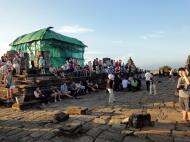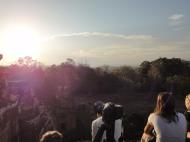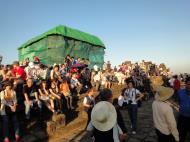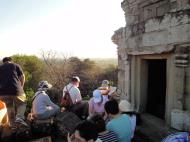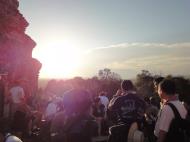Phnom Bakheng Temple
Name: Phnom Bakheng
Creator: Yasovarman
Date built: 889-910 A.D.
Primary deity: Shiva
Architecture: Khmer
Location: Angkor, Cambodia
Coordinates: 13°25'27?N 103°51'22?E / 13.42418°N 103.85601°EDedicated to Shiva, it was built at the end of the 9th century, during the reign of King Yasovarman (889-910 A.D.). The large number of visitors makes Phnom Bakheng one of the most threatened monuments of Angkor. Constructed more than two centuries before Angkor Wat, Phnom Bakheng was in its day the principal temple of the Angkor region, historians believe.
An inscription dated 1052 A.D. and found at the Sdok Kak Thom temple in present-day Thailand states in Sanskrit: "When Sri Yasovardhana became king under the name of Yasovarman, the able Vamasiva continued as his guru. Scholars believe that the passage refers to the consecration of the Phnom Bakheng temple approximately a century and a half earlier. Surrounding the mount and temple, labor teams built an outer moat. A causeway ran in a northwest-southeast orientation from the old capital area to the east section of the new capital's outer moat and then, turning to an east-west orientation, connected directly to the east entrance of the temple. Phnom Bakheng is a symbolic representation of Mount Meru, home of the Hindu gods, a status emphasized by the temple's location atop a steep hill.
The temple faces east, measures 76 meters square at its base and is built in a pyramid form of six tiers. Jean Filliozat of the Ecole Francaise, a leading authority on Indian cosmology and astronomy, interpreted the symbolism of the temple. The temple sits on a rectangular base and rises in five levels and is crowned by five main towers. One hundred four smaller towers are distributed over the lower four levels, placed so symmetrically that only 33 can be seen from the center of any side.
Thirty-three is the number of gods who dwelt on Mount Meru. Phnom Bakheng's total number of towers is also significant. Phnom Bakheng is one of three hilltop temples in the Angkor region that are attributed to Yasovarman's reign. For many years, scholars' consensus view was that the Bayon, the temple located at the center of Angkor Thom city, was the edifice to which the Sdok Kak Thom inscription referred.
Later work identified the Bayon as a Buddhist site, built almost three centuries later than originally thought, in the late 12th Century, and Phnom Bakheng as King Yasovarman's state temple. The view of the Angkor Wat from the top of Phnom Bakheng is featured in the movie Tomb Raider (when Lara Croft looks through the binoculars upon arriving in Cambodia).
Cambodian Elephant - Elephas maximus indicu
Physical characteristics
The Indian Elephant, Elephas maximus indicus, is one of four subspecies of the Asian Elephant, the largest population of which is found in India. The subspecies is also found in Bangladesh, Bhutan, Cambodia, China, Laos, Peninsular Malaysia, Burma/Myanmar, Nepal, Pakistan, Thailand and Vietnam. The other three subspecies of the Asian Elephant are the Sumatran Elephant (E. m. sumatranus), Sri Lankan Elephant (E. m. maximus) and Borneo Elephant (E. m. borneensis). Indian Elephants live in or near the forest jungle, although their habitat may vary. They tend to be nomadic in nature and do not stay in one place for more than a few days.
Body structure
Its height at the shoulder is between 2 and 3.5 metres (6.6 and 11 ft) and it weighs between 2.7 and 4.5 tones (3.0 and 5.0 short tons). It is taller and thinner than the Asian elephant found in Thailand. The largest Indian Elephant was 8 metres (26 ft) long, stood 3.5 metres (11 ft) and weighed 8 tones (8.8 short tons). Indian elephants look similar to African elephants but they have smaller ears and shorter tusks. Since Indian Elephants are a subspecies of the Asian Elephants, there are not many differences. Indian elephants have smaller ears, but relatively broader skulls and larger trunks than African elephants. Unlike their African cousins, their abdomen is proportionate with their body weight but the African elephant has a large abdomen as compared to the skuls.
Population & endangerment
The WWF considers the Indian Elephant widely distributed, but endangered. The current population of the Indian Elephant is in the range of 20,000-25,000. The Indian Elephant was assessed as an endangered species in 1996 by the Asian Elephant Specialist Group. Indian Elephants are threatened by poaching for the ivory of their tusks, by the loss of habitat due to human pressure on forested areas and due to human conflict. The isolated populations of wild elephants in individual wild sanctuaries are also threatened by loss of generated title.
Angkorian king Yasovarman I
Yasovarman I was an Angkorian king who reigned from AD 889-910.
Early Years
After the death of Indravarman I, a succession war was fought by his two sons. It's believed that the war was fought on land and on sea by the Tonle Sap.
Yasovarman I's achievements during his reign
During the first year of his reign, he built about 100 monasteries (ashrams) throughout his kingdom. Each ashram was used as a resting place for the ascetic and the king during his trips. In the middle of this lake (now dry), he built the temple Lolei. His greatest achievement was to move the capital from Hariharalaya to Yashodharapura where it remained there for 500 years.
It was at the new capital where all of the great and famous religious monuments were built, e.g. the Angkor Wat. For one the old capital was crowded with temples built by the previous kings. The decision was religious: In order for a new king to prosper, he must build his own temple and when he died it must become his mausoleum. The new capital was closer to the Siem Reap River and is halfway between the Kulen hills and the Tonle Sap. By moving the capital closer to the sources of water the king could reap many benefits provided by both rivers. He also constructed a road linking the old capital to the new one.
The Lolei, Phnom Bakheng, and the East Baray reservoir are monuments to this ruler, all located near Cambodia's national treasure, a later construction, Angkor Wat. Phnom Bakheng was one of three hilltop temples created in the Khmer Empire's Angkor capital region during Yasovarman's reign, the other two being Phnom Krom and Phnom Bok.
Phnom Bakheng Temple, Siem Reap, Cambodia Map
 Editor for Asisbiz: Matthew Laird Acred
Editor for Asisbiz: Matthew Laird Acred
If you love our website please add a like on facebook
Please donate so we can make this site even better !!












